March 18, 2011 — NASA's MESSENGER probe entered orbit around Mercury Thursday evening, making history as the first spacecraft to circle the innermost planet from the Sun. But even before the well-traveled craft fired its main thruster to enter Mercury's gravitational influence, a U.S. postage stamp was waiting to celebrate its success.
"I for one was never worried," said MESSENGER's project manager Peter Bedeni from the Johns Hopkins University Applied Physics Lab, about the probe's orbital insertion.
Neither apparently was the U.S. Postal Service. Sitting in a USPS facility somewhere are 30 million postage stamps inscribed with "First Spacecraft to Orbit Mercury."
"We understood that there might be risks," Roy Betts, USPS community relations manager, told collectSPACE a day before MESSENGER successfully entered orbit. "We recognize that there is always a possibility of something going wrong but we're optimistic."
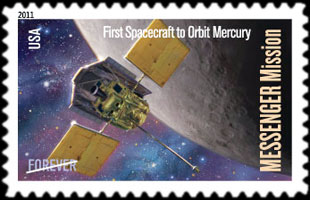
30 million of the "MESSENGER Mission" stamps were produced before the probe entered orbit around Mercury. (USPS) |
The stamps, which are scheduled for release on May 4 as part of a pair also commemorating Mercury astronaut Alan Shepard as the first American in space, were to be issued as is regardless of MESSENGER's fate.
"We plan to go forward," stated Betts, before he or anyone else knew that the spacecraft would live up to its stamp.
MESSENGER, which is NASA's abbreviation for MErcury Surface, Space ENvironment, GEochemistry and Ranging spacecraft, successfully achieved orbit around Mercury at approximately 8 p.m. CDT on Thursday after traveling 6.5 years, completing 15 orbits of the Sun. It'll spend the next year mapping the planet's surface.
Postal prediction
First announced in August 2010 and formally revealed last November, the "MESSENGER Mission" stamp shows the unmanned spacecraft orbiting the first planet from the Sun as envisioned by science fiction artist Donato Giancola.
At the time, the stamp's design was still the stuff of sci-fi.
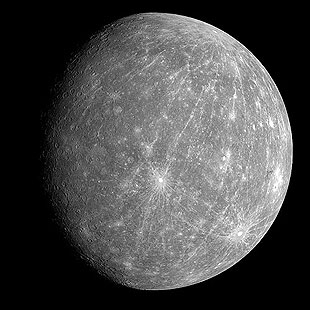
Planet Mercury, as captured by MESSENGER in October 2008 during its second of three flybys before entering orbit. (NASA) |
"Despite its proximity to Earth, the planet Mercury has for decades been comparatively unexplored," Sean Solomon, MESSENGER principal investigator, said in a statement. "For the first time in history, a scientific observatory is in orbit about our solar system's innermost planet."
"Mercury's secrets, and the implications they hold for the formation and evolution of Earth-like planets, are about to be revealed," Solomon said.
Only one other probe previously visited Mercury, flying by the small cratered planet three times between March 1974 and March 1975. Like MESSENGER, NASA's Mariner 10 spacecraft also was featured on a postage stamp. In fact, it graced two of the miniature commemoratives.
The first such stamp, released a few weeks after Mariner 10's final encounter with the planet, featured the probe nearing Venus with Mercury in the background. Mariner 10 was the first to use a "gravitational slingshot," employing Venus' pull to accelerate it towards Mercury. It was also the first mission to visit two planets.
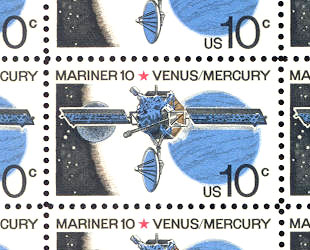
1975 "Mariner 10 Venus/Mercury" postage stamp (USPS) |
Mariner 10's second stamp came 16 years later as part of a series that included one design for each of the planets. The 29-cent stamps showed each planet being visited by a robotic probe, with Mariner 10 at Mercury.
For the design of the MESSENGER stamp, Giancola drew inspiration from NASA photographs and images. Though it has already returned photos of the planet taken during its own three flybys, MESSENGER won't send back its first images from orbit for another two weeks.
Giancola, who is known for his book cover illustrations for science fiction authors including Isaac Asimov and Arthur C. Clarke, worked on the stamp under the direction of Phil Jordan, a former art director for Smithsonian AIr & Space magazine.
Mercury mission meets Mercury astronaut
When released May 4, the MESSENGER stamp will come 10 to a sheet paired with a second stamp celebrating the 50th anniversary of the first American crewed space flight.
Referred to by philatelists as a "se-tenant," the pair differs in design but shares "Mercury" as a unifying theme.
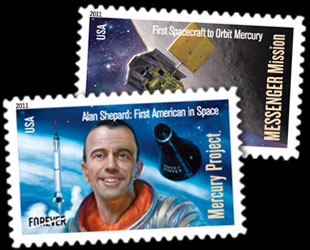
The "MESSENGER Mission" stamp will be issued as a se-tenant together with the "Mercury Project" stamp. (USPS) |
Alan B. Shepard, Jr., who flew on the Mercury-Redstone 3 suborbital mission, will be the first American astronaut to be honored on a U.S. stamp.
The commemorative, titled "Alan Shepard: First American in Space," also includes the words "Mercury Project." The design features Giancola's illustration of Shepard from his shoulders up centered between images of his rocket lifting off and his capsule above the Earth.
Since the early 1970s, U.S. stamp selection criteria have required an individual be deceased at least five years prior to their being eligible for consideration. Further, events of "historical significance" are limited for commemoration on anniversaries in multiples of 50 years.
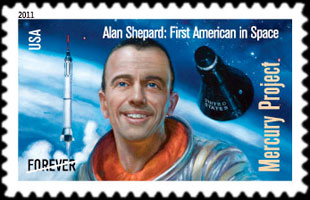
The "Alan Shepard: First American in Space" stamp will be the first U.S. postage to honor an specific astronaut. (USPS) |
Shepard died of leukemia at age 74 in July 1998. Although he was not the first astronaut to pass away, his first flight is the first U.S. manned mission to reach 50 years.
The Shepard and MESSENGER stamps' May 4 release is timed to follow the probe's arrival in orbit around Mercury and precede the 50th anniversary of the astronaut's flight on May 5, 2011.
"These two historic missions...frame a remarkable 50-year period in which America has advanced space exploration through more than 1,500 manned and unmanned flights," the USPS wrote in a press release.
Major Mercury milestone
Whereas Shepard's remarkable flight took just 15 minutes, MESSENGER needed to first fly 15 times around the Sun before it was set to make history.
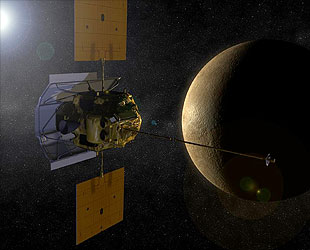
An artist's concept shows MESSENGER entering orbit. (NASA) |
"Achieving Mercury orbit was by far the biggest milestone since MESSENGER was launched more than six and a half years ago," said Bedini. "This accomplishment is the fruit of a tremendous amount of labor on the part of the navigation, guidance-and-control, and mission operations teams, who shepherded the spacecraft through its 4.9 billion mile journey."
The voyage included one flyby of Earth, two of Venus and three flybys of Mercury.
For the next several weeks, flight controllers will focus on ensuring the spacecraft's systems are all working well in Mercury's harsh thermal conditions near the Sun. Starting March 23, the probe's instruments will be turned on and checked out, and on April 4 the primary science phase will begin.
"You only go into orbit for the first time around Mercury once in human history and that is what was accomplished tonight," said Ed Weiler, NASA's associate administrator for the science mission directorate. "It only happens once in human history, and it is just beginning. We are going to learn a lot more about Mercury than we've ever dreamed of."
While in orbit, MESSENGER's instruments will record the first complete reconnaissance of Mercury's geochemistry, geophysics, atmosphere, magnetosphere, and geological history.
